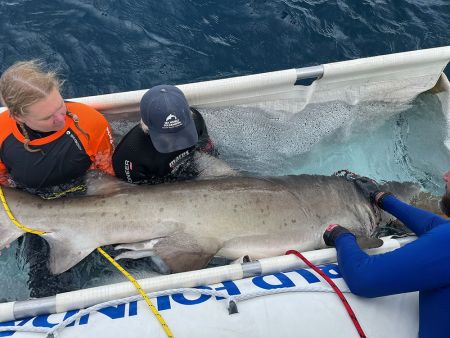Lassoing endangered grey nurse sharks to help protect the species


Lassoing a grey nurse shark may seem foolhardy, and not for the faint-hearted. But for the grey nurse shark research team, lassoing sharks is all in a day’s work at Flat Rock in the Moreton Bay Marine Park.
Waiting in the sea above the endangered grey nurse sharks is a lead diver holding a fixed structure—a long pole with a hoop and clipped rope at one end. Once the selected shark gets close, the diver carefully manoeuvres the ‘lasso’ into position and catches the shark. A Queensland Parks and Wildlife Service (QPWS) diver wearing a full-face mask with a communication system calls, “Shark on! Shark on!” to the team on the boat above.
Then, as Senior Conservation Officer Dr Carley Kilpatrick explains, the research team quickly pulls the shark up to the surface and either holds it in the water in a sling secured to the side of a smaller boat or lifts it into a specifically designed shark tank on the deck of a larger vessel.
The Australian east coast grey nurse shark population is estimated to be no more than 2,000 individuals, with a breeding population (males and females) of about 400 sharks.
“Nearly 30 sharks have been captured, tagged and released since 2015,” Dr Kilpatrick said. “Research has taught us that moving them relatively quickly to the surface is less stressful for the shark. Our goal is to tag and release the shark safely so we can learn from these tagged sharks for 10 years.”
The capture and tagging is a collaborative effort with QPWS staff working alongside other experts including vets from Seaworld and in-water technicians from the Biopixel Oceans Foundation. Along with divers and boat crew, the team swells to around 12 people on the day.
During tagging, a marine biologist monitors the shark’s breathing while a vet tags the shark and takes genetic samples. Within 40 minutes, the shark is released and the team watches it return to its group. Within a day, the team catches, tags and releases 2–4 sharks.


Satellite and acoustic telemetry
The team inserts a long-life acoustic tag inside the shark’s abdomen and anchors a satellite tag just below its first dorsal fin. The acoustic tags monitor the grey nurse sharks’ use of known critical aggregation sites. Over time, the tags also tell the team whether other locations, including sites in the Great Barrier Reef, where grey nurse sharks are detected are aggregation or gestation sites and whether they need protection. The purpose of the satellite tags is the same, but, importantly, they fill the gaps in areas with no acoustic receivers.
Acoustic receivers off the Queensland coast detect acoustic tags when a tagged shark is within range (about 800m). More than 300 receivers are deployed by various researchers, government agencies and the Integrated Marine Observing System’s Queensland Acoustic Array. Data stored on these receivers containing millions of detections of hundreds of different tagged animals gets shared on the Australian Animal Acoustic Telemetry Database.
The team programs satellite tags to pop off and float to the surface between 3–9 months after they are attached. A summary of data collected by the tag gets transmitted to the team via satellite. The tags transmit GPS signals and, if retrieved, provide a complete data set.
If the team cannot locate a shark tag, they ask the public to help search for it. People in coastal communities often find the tag first. Unfortunately, sometimes, the battery dies, and the signal stops before the tag’s found.


Expanding grey nurse shark knowledge
Tagging is only one component of an extensive program to protect grey nurse sharks in Queensland waters. The program relies on collaborative networks of people committed to processing the data, drafting research papers and publishing new knowledge as quickly as possible. By doing so, they encourage conservation management initiatives based on robust scientific evidence.
Dr Ross Dwyer at the University of the Sunshine Coast works with Dr Kilpatrick and post-graduate students to analyse, write up and share the knowledge the team is gathering.
Dr Kilpatrick explained hundreds of divers also contribute to grey nurse shark research.
“Years ago, I started a photo identification project, Grey Nurse Shark Watch—a citizen science monitoring program for the grey nurse shark population,” Dr Kilpatrick said.


“Dr Dywer is now leading a project, funded by the Queensland Government, that will compare historical photographic data with new photo ID survey data at Wolf Rock and Flat Rock. It is anticipated that this research will determine if the population is increasing and whether the number of sharks with fishing gear is decreasing since protection measures were implemented at these sites.
“Reviewing grey nurse shark photos to match them against existing pictures may seem like a perfect job for AI, but the technology is not yet as accurate as the human eye.
Despite many parties involved in collaborative efforts to protect the grey nurse shark, the research team is far from confident that the species is thriving.
“In an ideal world, we’d no longer have to lasso grey nurse sharks because we’d know the population was increasing, but for now, we still have so much work to do to ensure we are doing enough for the population to recover.”


